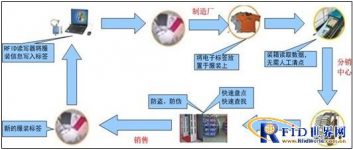
Ziyue Technology RFID Clothing Management Solution
[ad_1]
1. System overview
Competition in the apparel industry is becoming more and more fierce. To be invincible in the market competition, the apparel industry must continuously improve production efficiency and shorten the capital turnover time. According to market research and analysis, through informatization of the entire clothing industry, production efficiency can be greatly improved and capital turnover time can be shortened. At present, most of the clothing industry is all manual work, without any informationization, which leads to poor feedback of the entire information. When problems occur, they cannot be discovered and dealt with in time, which leads to the situation of idle work in many links. At the same time, the situation of product sales can not be grasped in time, leading to the out-of-stock of the best-selling products and the under-sales products, which also reduces the profit.
RFID technology can be informatized from clothing production, product processing, quality inspection, warehousing, logistics and transportation, distribution, and product sales, providing users with real-time dynamic tracking and query throughout the process; achieving information processing, system operation status, and business operation quality Monitoring and management, while providing real, effective, and timely management and decision support information for managers at all levels, providing support for the rapid development of the business, will be able to solve all problems, from now on comprehensively reduce costs, increase profits and competitiveness.
2. System structure and function
Clothing has the requirements of anti-counterfeiting, anti-theft, logistics distribution management and specialty store or store management. In the production process of clothing, an RFID card issuer is used to write some important attributes of a single piece of clothing into the RFID tag and the tag is attached to the corresponding On clothing, the uniqueness of the label can be used as a clothing anti-counterfeiting identification. The electronic tag attached to the packaging box can be used for distribution and adjustment during the delivery process. At the same time, the customer can take out the clothing abnormally through the RFID reader installed at the door. Wait for the situation to alarm and prevent.

2.1 Clothing anti-counterfeiting function
In the clothing production process, use the UHF card issuing machine to write some important attributes of a single piece of clothing such as: name, grade, article number, model, fabric, lining, washing method, implementation standard, product number, inspector number, etc. Enter the corresponding electronic tag and attach the electronic tag to the garment. The attachment method of the electronic tag can be: implanted in the clothing, made into a nameplate or tag, or adopts a recyclable anti-theft hard tag, etc. Each piece of clothing is given a unique electronic tag identification that is difficult to forge, which can effectively avoid counterfeiting and well solve the problem of clothing anti-counterfeiting.
2.2 Warehouse management
Due to the feature of RFID technology that can identify multiple tags at the same time under non-contact and non-visual conditions, that is, dozens of full boxes of clothing with electronic tags can be accurately read all of their logistics data at one time through an RFID reader , Which greatly improves logistics efficiency. If RFID technology is used to realize the warehousing management, the warehousing management of the logistics distribution center, and the warehousing management of the retail store, the entire supply chain of “shop replenishment demand—distribution center—manufacturer” can be realized. Optimal management of the process.
The use of RFID technology in warehouse management can realize the visual management of all management units, which can greatly shorten the packaging, handling, inventory, and statistics time, thereby reducing cargo damage, accelerating capital turnover, and greatly improving the efficiency of warehouse management.

[ad_2]






